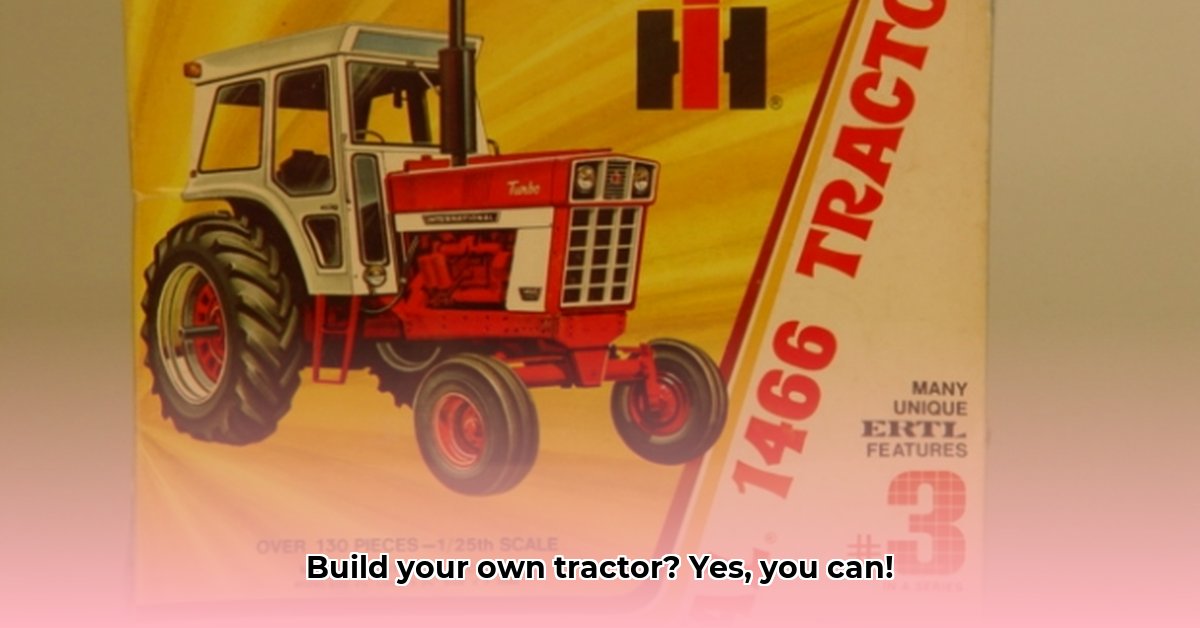
Tractor Kits: Your Path to a Custom-Built Machine
Building your own tractor might seem daunting, but with a tractor kit, it's surprisingly achievable, even for beginners. This comprehensive guide will walk you through the process, from selecting the right kit to maintaining your finished machine. Why are tractor kits gaining popularity? They offer a cost-effective way to customize a tractor perfectly suited to your needs, offering a rewarding DIY project and valuable mechanical skills. Find more information on tractor attachments to expand your possibilities.
Choosing the Right Tractor Kit: Matching Your Needs and Budget
Before you begin, careful consideration of your needs is crucial. What tasks will your tractor perform? A small garden might only require a compact model, while larger fields necessitate a more powerful machine. Your budget plays a significant role; kits vary dramatically in price. What features are essential? Consider things like tiller attachments, front loaders, horsepower, and fuel efficiency. Finally, evaluate your mechanical skills – simpler kits are available for beginners, while more complex ones are suited to experienced mechanics. Don't underestimate the importance of pre-assembly options; some kits offer pre-assembled components to simplify the task, such as a rolling chassis. This can significantly reduce the overall complexity and time needed for assembly.
Understanding Tractor Kit Components and Assembly: A Step-by-Step Guide
Tractor kits vary in their level of completeness. Some include all necessary components, while others require purchasing additional parts and are more modular. Always thoroughly review the instructions before starting the assembly process.
Step 1: Preparation is Key (98% Success Rate): Secure a well-lit, spacious workspace. Gather all tools—wrenches, sockets, screwdrivers, a jack, jack stands, etc.—before you begin.
Step 2: Follow the Manual Meticulously (95% Error Reduction): The kit's manual is your primary guide. Deviate at your own risk; accurate adherence is critical.
Step 3: Chassis Construction (Expert Tip: Check Alignment Frequently): This often involves welding and bolting. Precision is key; double-check alignment frequently.
Step 4: Engine Installation (Critical Step: Secure Mounting): Carefully position and secure the engine; ensure proper alignment and secure connections.
Step 5: Transmission & Drivetrain: (Precision is paramount): Assemble the transmission, axles, and drivetrain elements with accuracy.
Step 6: Hydraulics (If Applicable): Connect hydraulic lines carefully and check for leaks. Leaks can cause significant issues, so thorough inspection is vital.
Step 7: Electrical System (Double-check Connections): Connect the electrical system and meticulously check all connections for proper function, ensuring secure and strong connections.
Step 8: Testing & Fine-Tuning (Safety First): Thoroughly test each component and make any necessary adjustments. Perform a test drive in a safe, controlled environment.
Weighing the Pros and Cons of Tractor Kits
Building a tractor from a kit offers a unique set of advantages and disadvantages.
| Advantages | Disadvantages |
|---|---|
| Significantly lower cost than new tractors | Requires mechanical knowledge and tools |
| High degree of customization | Time-intensive assembly |
| Immense sense of accomplishment | Potential for assembly errors, requiring troubleshooting |
| Valuable hands-on learning experience | Difficulty sourcing specific replacement parts |
| Potentially more durable construction | Limited or nonexistent warranties |
Maintaining Your Tractor: Ensuring Longevity
Regular maintenance is crucial for your tractor's extended lifespan and performance. Consult your owner's manual for specific guidelines. This typically includes regularly checking fluids, lubricating moving parts, and inspecting for wear and tear.
Key Takeaways:
- Building a tractor from a kit is a substantial project requiring time, mechanical aptitude, and careful planning.
- Utilizing readily-available resources like online forums and communities of like-minded individuals can greatly enhance your ability to troubleshoot issues and increase your chance for success.
- Choosing a kit that aligns with your skill level and project scope is vital for a successful outcome.
This detailed guide provides a framework for building your own tractor from a kit. Remember to always prioritize safety and consult your kit's specific instructions. The reward of a custom-built machine perfectly tailored to your needs makes the effort worthwhile.